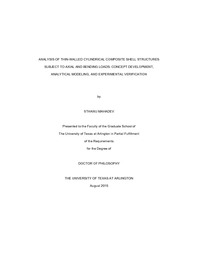
ATTENTION: The works hosted here are being migrated to a new repository that will consolidate resources, improve discoverability, and better show UTA's research impact on the global community. We will update authors as the migration progresses. Please see MavMatrix for more information.
Show simple item record
| dc.contributor.author | Mahadev, Sthanu | en_US |
| dc.date.accessioned | 2015-12-11T23:19:54Z | |
| dc.date.available | 2015-12-11T23:19:54Z | |
| dc.date.submitted | January 2015 | en_US |
| dc.identifier.other | DISS-13012 | en_US |
| dc.identifier.uri | http://hdl.handle.net/10106/25321 | |
| dc.description.abstract | Several studies have focused on the modeling and response characterization of composite structural members, with particular emphasis on thin-walled cylindrical composite shells. This class of shell configurations is explored to determine their mechanical response in primary aerospace structural members. The present work is focused on formulating a modified composite shell theory prognosis methodology for investigating the structural response of thin-walled cylindrical shell type composite configurations under axial and bending loads, respectively. The prime motivation to develop this theory arises from its capability to generate simple yet accurate closed-form analytical results that can efficiently charecterize cylindrical composite shell constructions. This work shows the development of a novel mathematical framework to predict key structural characteristics such as axial stiffness, bending stiffness, and centroid for thin walled composite shells. Longitudinal components of ply-stresses are analytically computed through the global stiffness matrix model for cylindrical composite tubes under thermomechanical environments. An ANSYS based FE routine is employed to compare against the analytical results. This concept development is further extended to analyze thin-walled, open cross-section, curved composite shells characterized by circumferential v arc angle, thickness-to-mean radius ratio, and total laminate thickness, respectively. The potential of this methodology is used to analytically identify the location of the centroid for such cross-sections. Ply stress variations for curved cylindrical shells are analytically examined under the application of centroidal tensile and bending loadings respectively. In-plane ply-stress estimations determined by the present model show excellent agreement in comparison with FEM results. The present work also incorporates the design and manufacturing of a novel ad-hoc testfixture set-up to experimentally characterize the extension-bending behavior in open cross-section curved composite strips. Seven symmetric, balanced curved composite test specimens are fabricated. This investigation introduces a new testing methodology to measure longitudinal surface strain fields and predict the centroid location via implementing a non-contact, full field strain measurement technique, Digital Image Correlation (DIC). Experimental measurements are compared against analytical results. This work is shown to essentially capture the mechanical response of cylindrical shells by providing an efficient and effective mathematical tool for structural engineers. | en_US |
| dc.description.sponsorship | Chan, Wen | en_US |
| dc.language.iso | en | en_US |
| dc.publisher | Aerospace Engineering | en_US |
| dc.title | Analysis Of Thin-walled Cylindrical Composite Shell Structures Subject To Axial And Bending Loads: Concept Development, Analytical Modeling And Experimental Verification | en_US |
| dc.type | Ph.D. | en_US |
| dc.contributor.committeeChair | Chan, Wen | en_US |
| dc.degree.department | Aerospace Engineering | en_US |
| dc.degree.discipline | Aerospace Engineering | en_US |
| dc.degree.grantor | University of Texas at Arlington | en_US |
| dc.degree.level | doctoral | en_US |
| dc.degree.name | Ph.D. | en_US |
Files in this item
- Name:
- Mahadev_uta_2502D_13012.pdf
- Size:
- 55.56Mb
- Format:
- PDF
This item appears in the following Collection(s)
Show simple item record


